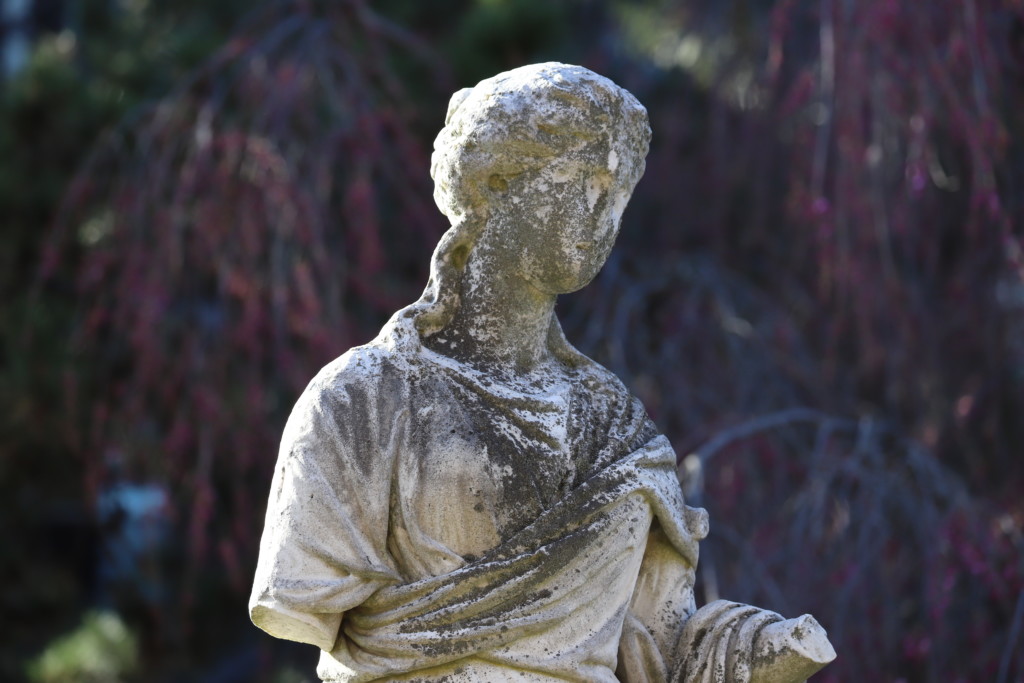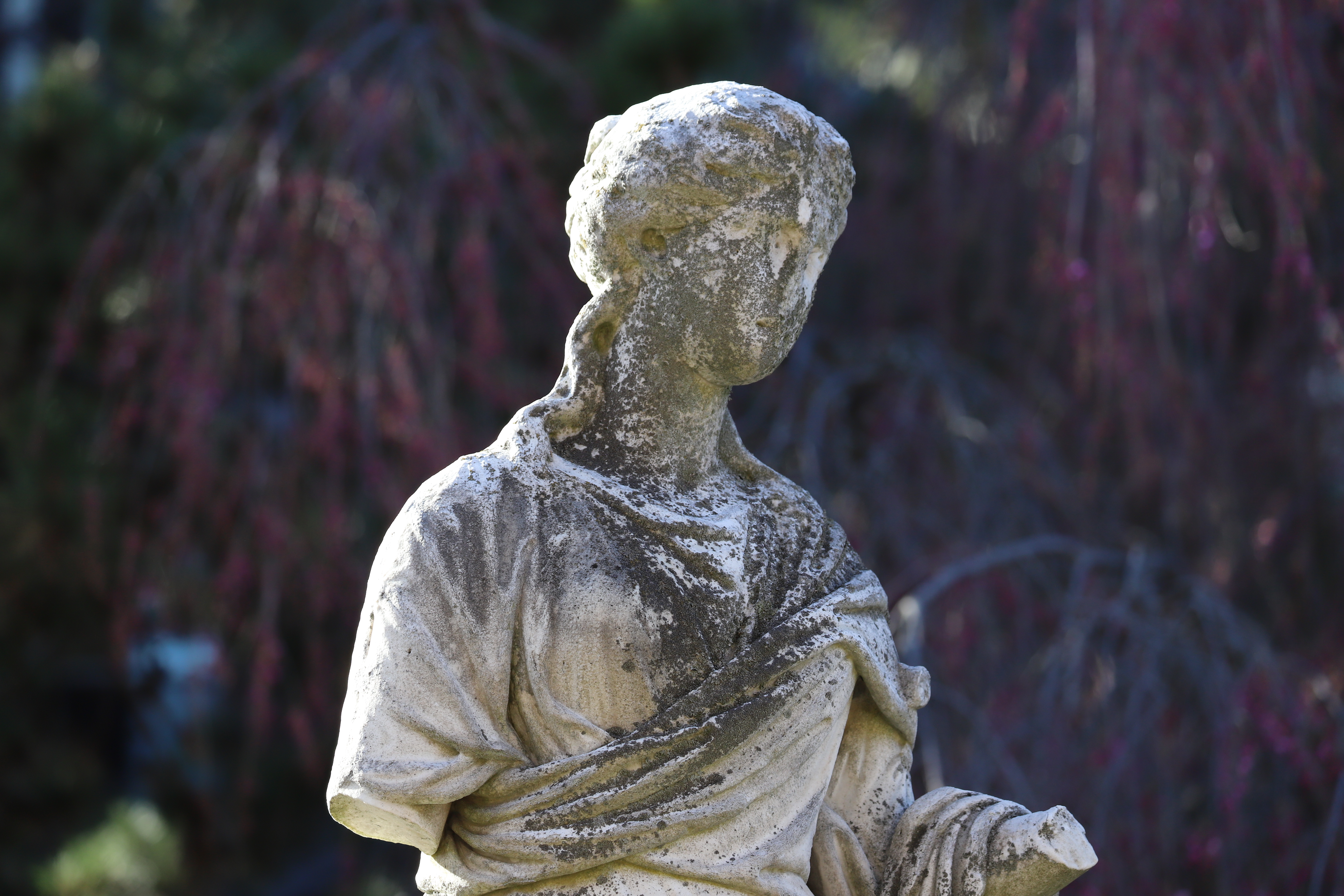Outside Meliora Hall, four women stand limbless. Their white exteriors are weathered with speckles of decay. One of them is headless.
There are 11 sculptures of women in public view on the River Campus. The other 15 are of men.
The men all have their limbs, and their heads remain attached.
The state of female iconography on campus, and lack of it, has elicited a call for more representation in a report released last May by the Commission on Women and Gender Equity in Academia.
“People we honor seem to be more and more men, white men in particular,” co-chair of CWGEA Amy Lerner said. “We have hundreds of women alumni who are super important. Where are they?”
“Once you see it, it’s hard not to notice,” the CWGEA report says.
Looking at the collection of statues near Meliora, facial features are unrecognizable due to the erosion. Eyes, noses, and mouths are lost to time.
Along with a fully intact statue near the Simon School, the collection represents branches of knowledge: industry, geography, astronomy, navigation, and commerce.
The other six female sculptures can be found at Rush Rhees. Two reside on the triangular pediment above the library’s front pillars. Inside, Athena, goddess of wisdom, stands opposite a female statue representing industry, short a finger for some time, according to UR archivist Melissa Mead. Two busts of Greek goddesses jut from above the Hawkins-Carlson and Welles-Brown room entrances.
Like the other female sculptures on campus, those in Rush Rhees have no relation to Rochester or the University. 10 sculptures on campus depict men who impacted Rochester.
“The women are nameless as they are these universal attributes that are idealized and not rooted in real, physical bodies or experiences or achievements,” said Joan Saab, a professor of art history. “That’s the issue.”
But is there an issue if they are just sculptures?
Psychology professor Marie-Joelle Estrada sees multiple aspects to how the imbalanced iconography can subconsciously affect the campus community.
She explained that the four faceless statues contribute to face-ism, the idea that a face is necessary to be a person rather than a thing.
“Something as simple as a faceless, but beautiful female sculpture says a lot about what’s valued and says a lot about the source of power,” Estrada said.
She mentioned the role model effect, which focuses on how “you can’t be what you can’t see.” When groups are misrepresented, Estrada said, it reinforces negative stereotypes of not belonging.
“It’s scary to be the first one even though you are not the first one,” Estrada said.
“Especially at an institution of higher learning, you want to highlight how women have made substantial and intellectual contributions across the board,” she later added.
Four UR students also questioned the underrepresentation in a class project last semester. Junior Skye Waipa, sophomores Saffiatu Kaiwa and Salma Khai, and first-year Haris Kalač looked to informally examine the numbers of women and men iconography on campus.
The group reported a stark difference in how plaques and portraits portrayed men and women. More often than not, the results showed, women were represented in plaques and portraits next to husbands or brothers.
After interviewing 61 students on the results, Kalač said many participants did not notice the disparities.
Additionally, the group found that other colleges, including Oxford University and Princeton University, had recently commissioned new iconography on campus to reflect their diversity.
“[At Oxford], they asked students and faculty to nominate relevant individuals or groups to be depicted in portraits,” Kalač said. “This idea could be definitely accomplished on our campus.”
But Mead said there are important historical reasons for the disparities between male and female iconography.
UR was exclusively male from 1850–1900, then became co-ed for 13 years before splitting into separate colleges for men and women.
“The college for women comes to River Campus in 1955 and leaves Prince Street Campus, which meant they could have left [iconography] there as well,” Mead said.
Moreover, those Meliora statues are headless and limbless for a reason: they’re from 1874, according to Mead.
“This is just age,” Mead said. “They came to us whole with features and hands and heads.”
The statues were new when they first filled the niches in Sibley Hall, the Prince Street campus library. When moved to their current spot in 1979, they had lost parts but were clean.
These statues were a 25th-anniversary gift from the class of 1955, the first co-ed class since 1913. Mead does not think UR will ever take them down.
Mead also addressed why some of the walls on campus are covered with portraits of just white men.
“Often times, there are designated spaces for portraits,” Mead said, like the spaces designated to the chairs of the Board of Trustees and the presidents.
“If we were going to say there should be more women in a particular space, we would have to undesignate the space,” Mead said.
But fourth-year UR medical student Antoinette Esce thinks it’s time for a change.
“Maybe that’s not what we do anymore,” Esce said of designated spaces like the Great Hall exterior. “Maybe we find a different place to efficiently honor our presidents and use that very public space to have a more representative style of portraits or art for the campus community.”
The designated space for portraits of Board of Trustees chairs is actually inaccurate.
The space does not feature a portrait of Virginia Dwyer, the only female chair of the Board of Trustees. Mead has been persistent about getting an oil painting of Dwyer hung up with the men, but these types of changes can only be issued by the Office of the President.
Another complicating factor is finding a source of funding for new iconography.
Moving forward, Saab formed an art committee last year that is set to officially inventory campus iconography this summer.
Esce, Lerner, and Saab believe the University should find ways to protect the history that is here. Additionally, they want to honor women past and present, as well as more minorities and LGBTQ, through iconography.
For now, Lerner described a way to stand up against the lack of representation. She recently visited the National Academy of Sciences building in D.C. As she walked around, she stopped when she saw “yet another wall of white men.”
She recounted turning to an African-American colleague and asking, “Feel really at home in this space, don’t you?”
He agreed.
“I think we need a photo of the two of us standing here,” Lerner said.
Her colleague smiled and they posed.
“And so, we put our faces on the wall.”


